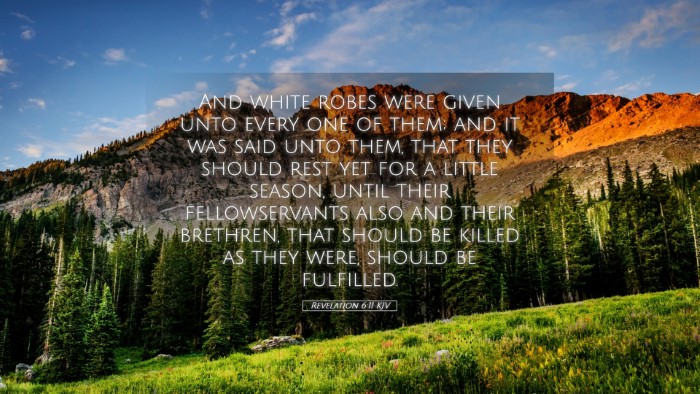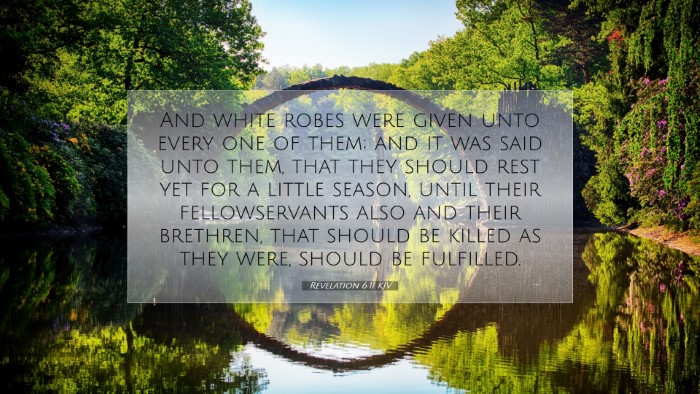Commentary on Revelation 6:11
Verse: “And white robes were given unto every one of them; and it was said unto them, that they should rest yet for a little season, until their fellowservants also and their brethren, that should be killed as they were, should be fulfilled.”
Introduction
The sixth chapter of Revelation unfolds a dynamic scene where the souls of martyrs seek divine justice. In verse 11, a pivotal moment occurs as white robes are bestowed upon them—a symbol of victory and purity. This commentary synthesizes insights from various public domain commentaries, including those by Matthew Henry, Albert Barnes, and Adam Clarke, to provide a multi-faceted understanding of the passage.
Contextual Background
- Setting: The opening of the fifth seal reveals the souls under the altar, representing the faithful who have suffered persecution for their faith.
- Thematic Relevance: This vision is integral to the apocalyptic narrative, emphasizing the costs of discipleship and the ultimate triumph over evil.
Insights from Commentaries
Matthew Henry's Commentary
Henry highlights the significance of the white robes, indicating that they represent the righteousness of Christ. He notes that the bestowal of these robes signifies acceptance and honor from God. Furthermore, he states that rest is promised to the martyrs until the fulfillment of God's plans, portraying a divine patience and assurance that justice will be served.
Albert Barnes' Notes
Barnes elaborates on the idea of rest and the timeframe mentioned in the verse. He interprets "a little season" as a period granted by God for the completion of the martyr's fellowservants’ sufferings. He poses that this implies God's providential control over both time and suffering, ensuring that all appointed trials are comprehensively fulfilled before His final judgment.
Adam Clarke's Commentary
Clarke emphasizes the significance of the white robes as an emblem of purity, indicating that martyrs are vindicated and honored in heaven despite their earthly sufferings. He also draws attention to the community aspect of faith, as it is not just individual martyrs but their "fellowservants" who are included in this heavenly vision. The promise of eventual vindication suggests a collective journey of the faithful, which Clarke believes enhances the hope and perseverance of believers amidst trials.
Theological Implications
- Symbolism of White Robes: The white robes symbolize purity, victory, and the righteousness that comes from Christ. This reflects an ecclesiological truth that all believers, despite earthly trials, are clothed in righteousness.
- Divine Justice: The assurance of rest for the martyrs underscores God's commitment to justice, encouraging believers in their faith amidst ongoing trials, assuring them of divine oversight.
- Community of Faith: The mention of "fellowservants" illustrates the importance of community within the body of Christ. The suffering of one is the suffering of all—a reminder of solidarity in the faith journey.
Conclusion
Revelation 6:11 encapsulates profound truths about suffering, righteousness, and the eschatological promise of justice. By synthesizing perspectives from Henry, Barnes, and Clarke, we gain a richer understanding of the comfort offered to believers and the assurance of God's ultimate plan. This passage not only serves as a reminder to pastors and theologians of the reality of suffering but also aligns their ministry with the hope of resurrection and eternal rest in God’s presence.
Reflection Questions
- How can the understanding of the white robes influence our view of holiness and righteousness in ministry?
- What does the promise of rest mean for believers facing persecution in today’s context?
- In what ways can we cultivate a sense of community among fellow believers who are enduring suffering?


